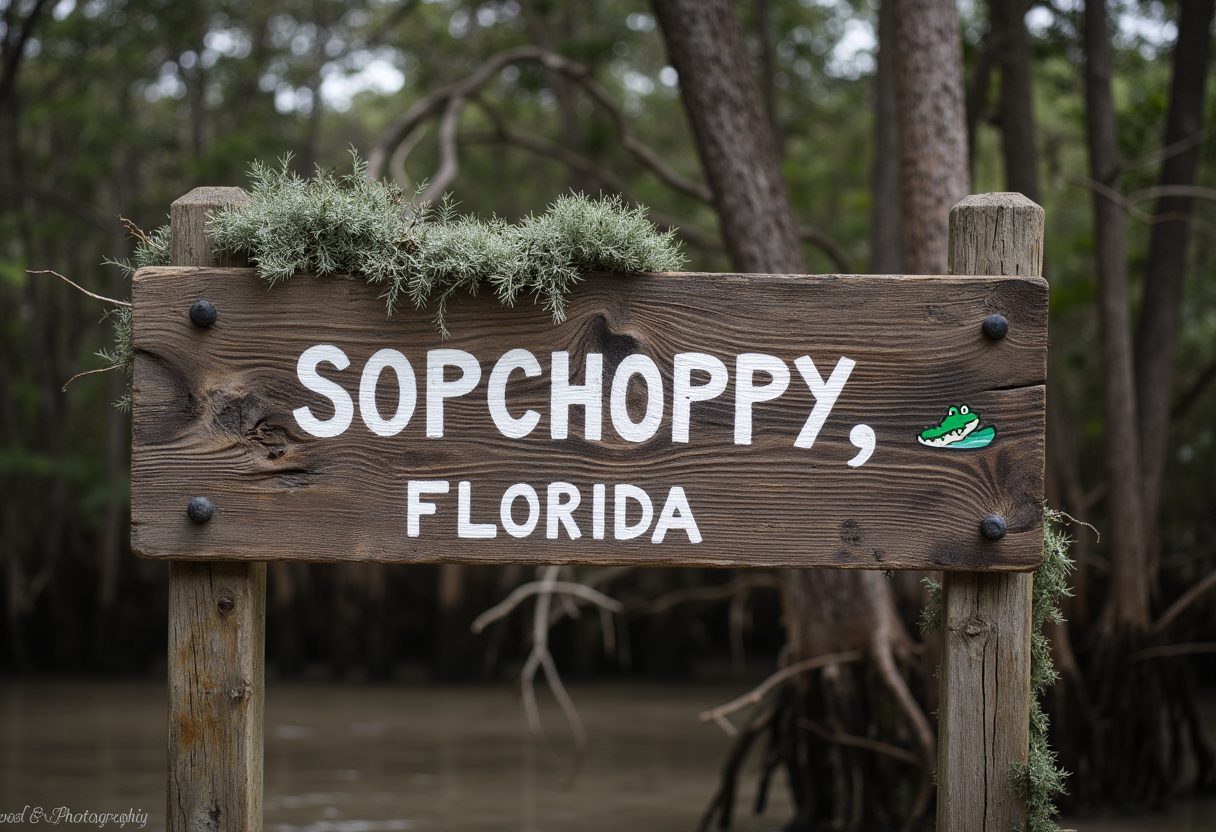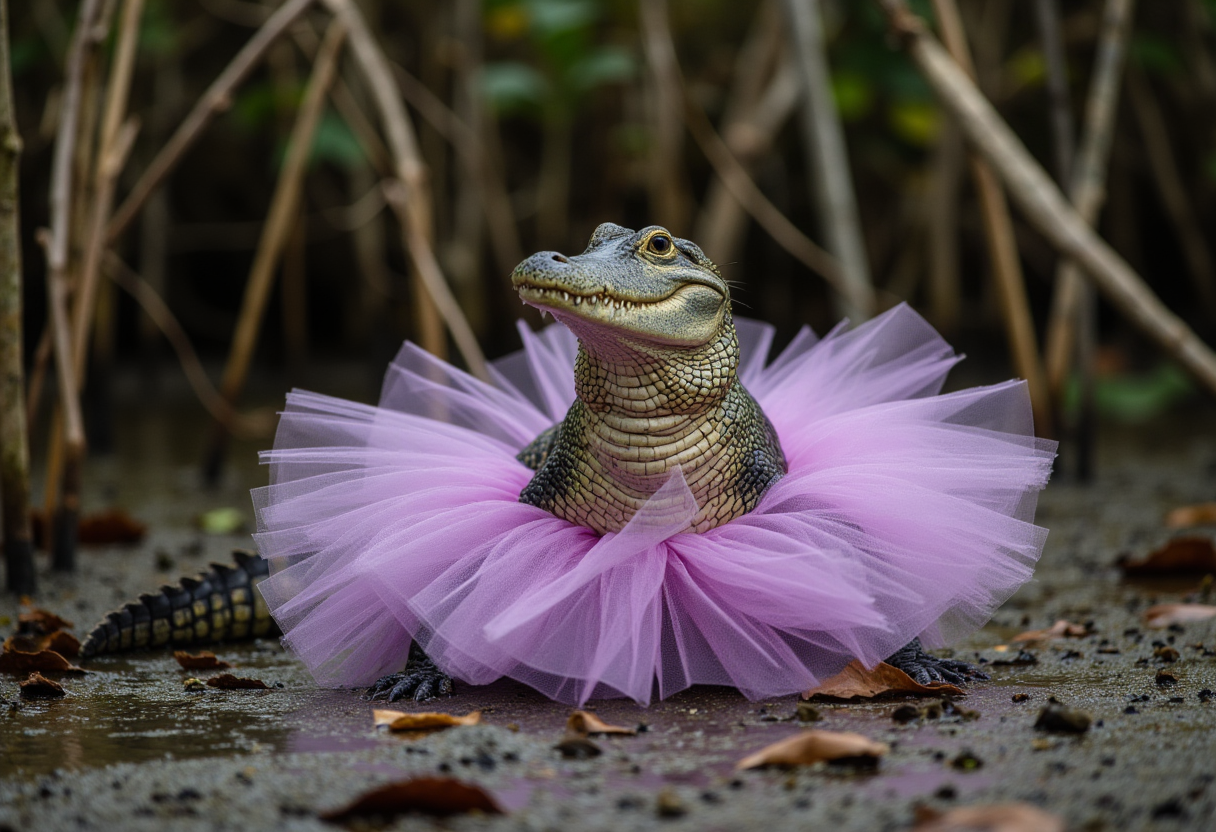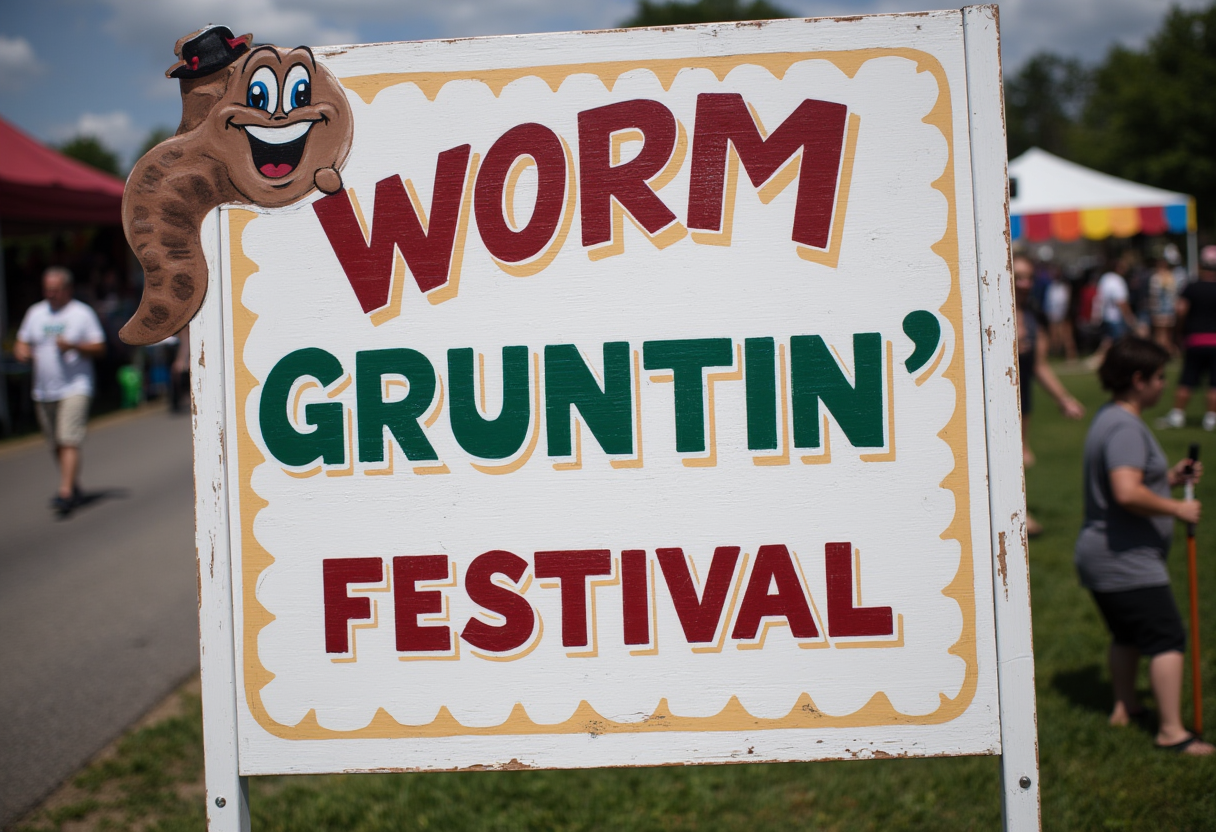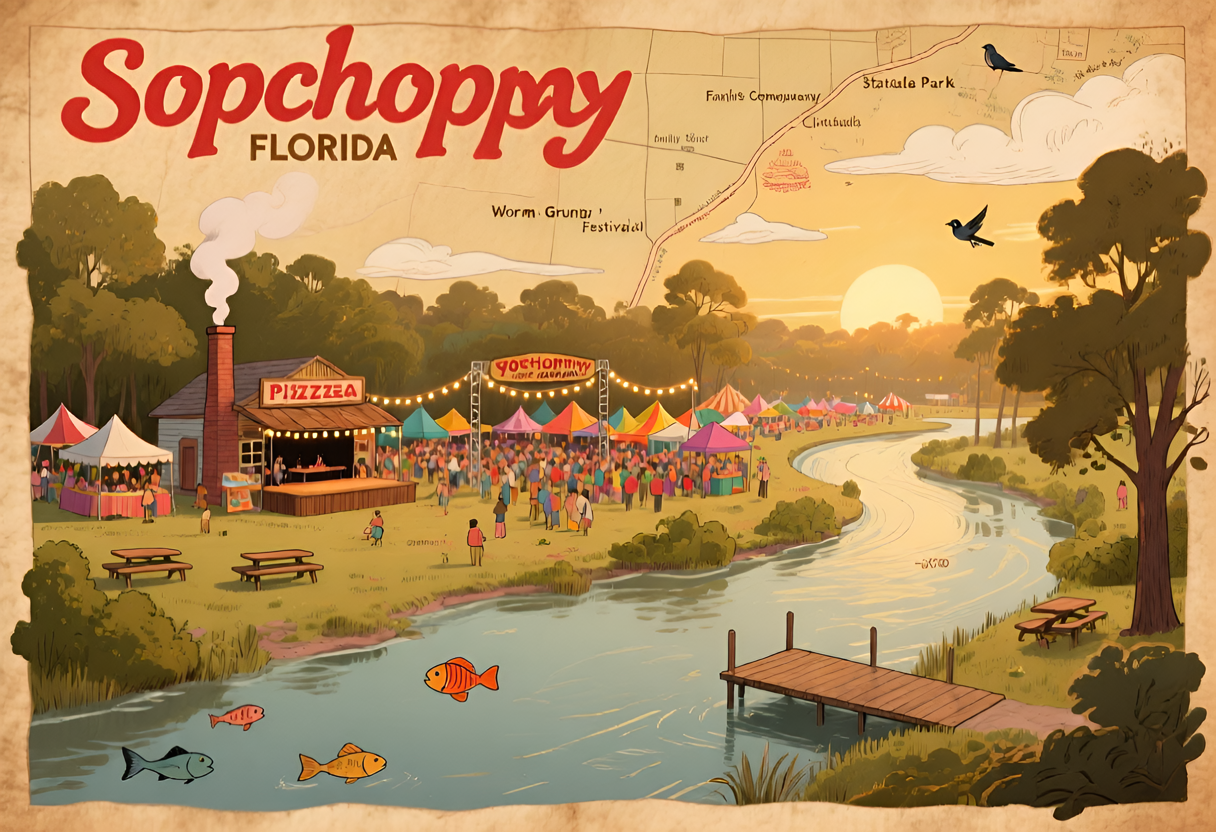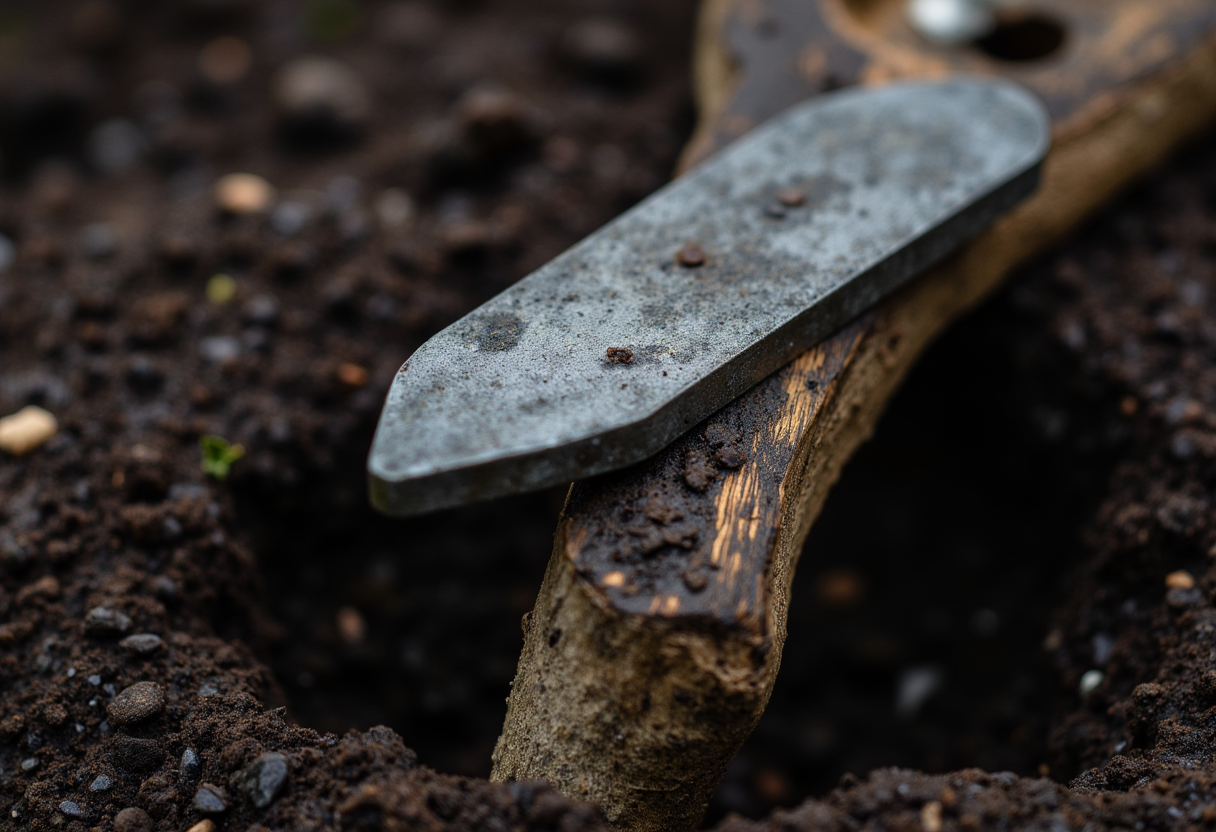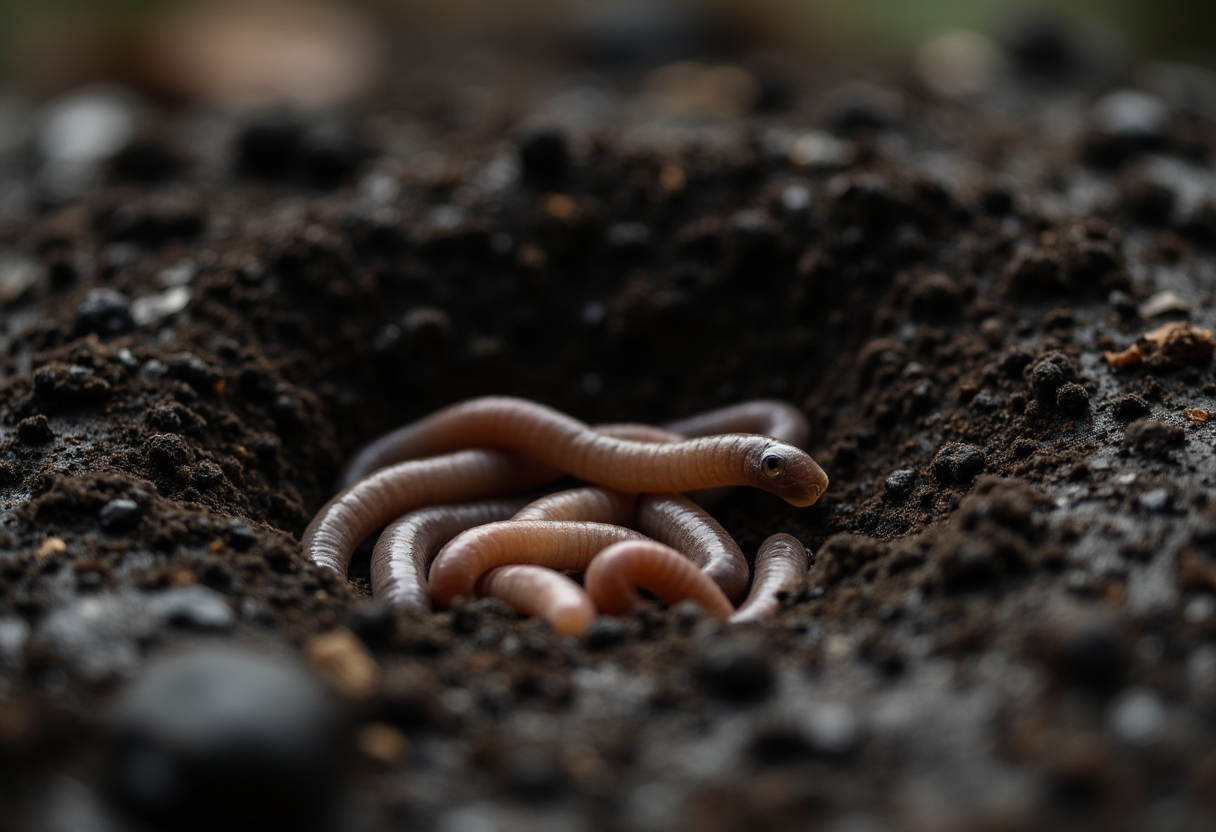Sopchoppy, FL: Where the Worms Wear Sunglasses and the Locals Grunt with Pride (Seriously)
A weathered, rustic wooden sign with "Sopchoppy, Florida" hand-painted on it, with Spanish moss draped over the top or a small, cartoonish gator illustration peeking from behind it.
Welcome to Sopchoppy, Florida — a tiny Panhandle town with a big personality, equal parts down‑home charm and delightful oddity.
Tucked well away from South Beach’s neon and Orlando’s theme‑park frenzy, Sopchoppy sits amid pine and river, where community traditions and a healthy sense of humor define daily life.
This is a place where worms are local celebrities: the town’s signature Worm Gruntin’ Festival draws visitors who come to watch people coax earthworms from the soil, celebrate local food, and soak up genuine small‑town Florida culture.
With a population hovering around a cozy 450 (please confirm with the latest census), Sopchoppy isn’t merely a dot on the map — it’s a living snapshot of regional tradition, ecosystems where soils and waterways support diverse life, and a community that embraces the quirky as part of its identity.
Plan your visit around the festival in April (verify exact dates) to experience the grunting firsthand — and bring curiosity, comfortable shoes, and an appetite for local flavor.
The Grunt Heard ‘Round the World (Or At Least, the Panhandle)
(Image: Festival sign with hand-painted lettering, perhaps with a joyful worm mascot peeking over the top. Title overlay: "Worm Gruntin' Festival: Come One, Come All (Especially If You're a Worm)")
So what puts Sopchoppy on the map? Not a secret moonshine recipe, not a pristine beach — it’s the town’s unmistakable Worm Gruntin’ Festival. This annual April event celebrates the age‑old, vibration‑based method of coaxing earthworms from the soil and has become the town’s biggest draw.
Gator in a Tutu (Whimsical): A playful, slightly absurd image of an alligator wearing a brightly colored, perhaps slightly ill-fitting, pink or purple tutu. It's sitting casually, maybe even striking a pose, in a swampy, natural Florida setting.
Worm grunting (also called worm charming or worm fiddling) uses simple tools and deliberate rhythm to encourage worms to the surface. Practitioners plant a sturdy stake — often called a "stob" or simply a post — and rub a flat iron rod across the top to transmit vibrations into the ground.
The worms respond to those vibrations (which mimic surface disturbance) by coming up to the surface — a practical technique turned curious spectacle.
How it works (brief):
The grunter places a stob or stake in the soil and applies rhythmic pressure with a rooping iron or similar rod.
Vibrations travel through the soil and are sensed by the worms’ body systems, prompting them to surface.
Harvesters collect the earthworms for bait or, during the festival, for sport and spectacle.
What to expect at the festival: thousands of spectators (organizer attendance figures should be checked for accuracy), rows of contestants, live music, vendors selling local food and crafts, and plenty of good‑natured competition.
Contestants bring their own tools and techniques; judges often reward speed, technique, and the biggest haul. Kids love watching the wriggling creatures break the surface, and local bands add to the fair atmosphere.
A few practical notes for visitors: confirm exact April dates with the festival organizers, check parking and entry fees, and wear sturdy shoes for soft or muddy ground. Bring water, sunscreen, and an appetite for regional fare — you’ll find everything from barbecue to pickled sides at vendor stalls.
Origins and growth: what began as a local bait‑harvesting method has grown into a cultural event. The festival—reported to have started in 2000—has expanded from a small community gathering to an event that draws out‑of‑town visitors eager to see the unique tradition in action. If you’re researching the practice,
Worm Gruntin' Festival Sign: A vibrant, folksy hand-painted festival sign. The lettering for "Worm Gruntin' Festival" is bold and perhaps a little wobbly, giving it a charming, homemade feel.
look for primary sources on local history and interviews with long‑time residents to verify early dates and attendance claims.
Images and accessibility: add descriptive image alt text such as "Worm Gruntin' Festival crowd in Sopchoppy — people using stobs and iron rods to coax earthworms from soil" to improve discoverability and assist readers using screen readers.
Whether you come for the science, the spectacle, or the sheer novelty, Sopchoppy’s Worm Gruntin’ Festival is an unforgettable example of how a simple method for collecting bait can become a beloved community tradition. Plan ahead, check festival details, and prepare to witness the curious dance of humans, tools, and wriggling creatures surfacing from the soil.
(Image: Locals “grunting” with tools in the soil, perhaps with a look of intense concentration or mischievous glee on their faces.)
Picture it: a dusty field transformed into an arena of rhythmic rubbing and expectant gazes. Contestants, armed with their stobs and rooping irons, grunt with admirable dedication, their faces a mix of focused concentration and the quiet thrill of a successful worm exodus.
Children giggle as worms emerge. Live music pulses through the air, local vendors hawk their wares, and the whole scene feels part small‑town fair, part natural‑history demonstration — entirely, beautifully Sopchoppy.
A Stream of Quirky History
The name "Sopchoppy" is widely believed to derive from a Muskogee word meaning "twisting stream," a fitting image for a town shaped by rivers, wetlands, and winding roads. (Confirm the exact etymology with local historical sources or tribal language references.)
Sopchoppy’s history is rooted in the rhythms of the land — timber, river travel, and small‑scale agriculture — and those currents of daily life helped give rise to practical traditions like worm grunting. The practice began as a method for collecting bait,
relying on vibrations traveling through soil to coax earthworms to the surface for local anglers and families.
Over time, that functional technique became a community ritual and now serves as a reminder of how local knowledge, body‑memory, and regional ecosystems combine to sustain both people and animals in this part of the Panhandle.
The Flavor of the Land (and the Worms)
Beyond the wriggling spectacle of the Worm Gruntin’ Festival, Sopchoppy serves up a satisfying slice of Panhandle life: small businesses, river wilderness, and community traditions rooted in the land and soil that sustain them.
(Image: Vintage-style map of Sopchoppy with key landmarks highlighted: Worm Gruntin' Festival grounds, Sopchoppy Pizza Company, Ochlockonee River State Park.)
Sopchoppy Pizza Company: Ditch the chains and try this local favorite — a casual spot where fresh ingredients and friendly service shine. Locals rave about the flavors, and you’ll often hear folks joke they’d trade a successful grunt for a perfect slice.
The menu highlights regional tastes and approachable comfort food; check current hours and whether reservations are needed before you go. Eating here is a chance to taste a bit of community — and yes, there’s often lively conversation about worms, baiting methods, and festival lore.
If you’re curious about food systems and local sourcing, ask the owners where they get produce and proteins — small places like this often work with nearby farms and markets, linking the town’s table to the surrounding habitats that support plants, micro‑organisms, and the creatures that live in the soil.
Ochlockonee River State Park: For outdoor exploration, the park offers kayaking, wildlife viewing, and quiet trails. Expect Spanish moss draped on oaks, cypress knees at the river edge, and the steady presence of wildlife — from birds and small mammals to reptiles that share the waterways with abundant aquatic and terrestrial species.
Kayaking here puts you close to the water’s surface and into habitats where nutrients cycle between land and river: leaves and organic matter break down, micro‑organisms and invertebrates process nutrients and molecules,
and species from fish to birds depend on that network of life. Check park maps, launch points, rental options, and any permit or fee requirements before you head out.
Practical tips: wear shoes suitable for soft, sometimes muddy ground, bring water and insect repellent, and keep a safe distance from alligators. Respect the ecosystem — avoid disturbing banks or vegetation where earthworms and other creatures make their home.
Close-up of "Stob" and "Rooping Iron": A detailed shot focusing on the tools of worm grunting.
(Image: River scene with cypress knees and fog, conveying a sense of mystical, wild Florida beauty.)
Florida Unwritten Moment: The Worm Whisperer
This one reads like local folklore: residents in town will tell you about a legendary grunter—Old Man Tremble—whose reputation borders on myth. Whether he actually existed or represents a composite of many skilled locals, the story captures Sopchoppy’s appetite for colorful characters.
According to the tale, Tremble didn’t need a rooping iron; a single, polite stomp of his foot would send vibrations through the soil, and the worms would surface as if summoned.
Witnesses claim worms emerged fat and glistening, sometimes described with names—“Come on out, Beatrice!”—a humorous detail that underlines how closely the community ties its identity to this quirky practice.
Label this a local legend rather than a verified historical fact unless you can confirm it with interviews or archival sources; the value of the tale lies in what it reveals about community memory.
Folklore like this helps explain why worm‑grunting evolved from a practical method for collecting earthworms into a festival that honors local knowledge, body‑memory, and the close relationship between people and the soil that sustains local food and wildlife.
If you collect stories here, attribute them clearly—note who told you the tale and when—so readers can distinguish affectionate myth from documented history.
The Verdict: So Much More Than Just Grunting
Sopchoppy is more than a novelty — it’s a working example of how local knowledge, community life, and regional ecosystems intersect. The town captures the spirit of small‑town Florida: unexpected traditions, close ties to the land, and a willingness to celebrate the odd and the ordinary in equal measure.
Worms Emerging (Close-up): A macro shot focusing on multiple earthworms wriggling and emerging from damp, dark soil.
Visit for the Worm Gruntin’ Festival (typically held in April — confirm exact dates), then stay to explore river trails and local eateries. Drive quiet, tree‑lined roads under live oaks, breathe air scented with pine, and listen for the familiar rhythms of the rooping iron: thump‑thump‑rub.
Practical planning tips: check festival dates and parking/entry details with organizers, bring water and sun protection, wear shoes suitable for soft, sometimes muddy ground, and respect wildlife — keep a safe distance from alligators and other animals.
If you’re interested in ecosystems, note how soils and waterways act as systems that cycle nutrients and matter: earthworms and micro‑organisms help break down material, returning nutrients to plants and supporting a network of creatures both in water and on land.
Sopchoppy proves that even the humblest worm has an important role in the body of an ecosystem — and in the story a town tells about itself.
So the next time you plan a Florida trip, consider the Panhandle: skip the crowds, embrace the local quirks, and you may well come away with a story (and a picture) worth sharing.
Related Reads for Your Florida Unwritten Journey:
Matlacha: Where Color Never Retires: If Sopchoppy’s offbeat charm appeals to you, Matlacha’s vibrant waterfront art and galleries are a great companion stop.
Weeki Wachee: Mermaids, Manatees, and Magic: For more classic Florida weirdness, check out Weeki Wachee Springs — a mix of live shows and natural springs.
Carrabelle: The World’s Smallest Police Station: A short drive away, Carrabelle’s tiny historic station is a fun detour if you’re touring the Panhandle’s lesser‑known sites.
Earl Lee
Florida Uwritten
"Thanks for reading. Until next time, keep exploring Florida's peculiar charm!"
Florida Unwritten Staff

